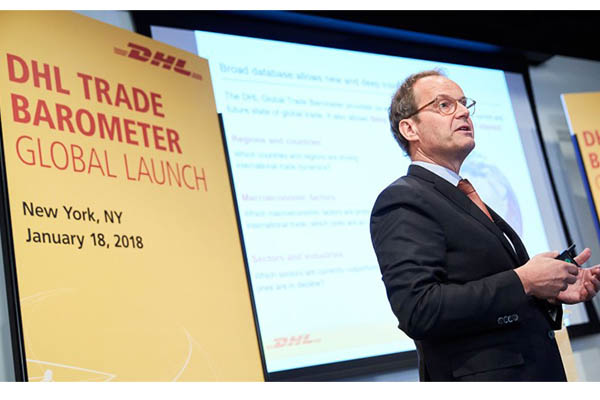DHL’s Global Trade Barometer shows gains
Global express delivery and logistics services provider DHL said this week that the most recent edition of its quarterly Global Trade Barometer continues to trend in the right direction, with various indicators pointing to a strong global trade outlook.
Global express delivery and logistics services provider DHL said this week that the most recent edition of its quarterly Global Trade Barometer continues to trend in the right direction, with various indicators pointing to a strong global trade outlook.
Launched in January, the Global Trade Barometer, according to DHL, is an early indicator for the current state and future development of global trade, adding that it is the result of a partnership between DHL and Accenture, whom provides data modeling and predictive analytics to forecast future trends for DHL.
DHL explained that the Global Trade Barometer is based on import and export data for a number of intermediate and early-cycle commodities that serve as the basis for further industrial production such as brand labels for clothes, bumpers for cars or touch screens for mobile devices. And it noted that sources are aggregated market data from air and containerized ocean freight in seven countries that represent more than 75 percent of world trade. The barometer leverages artificial intelligence and statistical models to compress the data into a single index value that is published on both a global and individual level for the seven countries it evaluates.
The reading for this edition of the Global Trade Barometer came in at 66, which is ahead of the inaugural edition’s 64. This figure marks the weighted average of the current growth and next two months of global trade, with a reading of 50 or higher indicating a positive development and a reading below 50 indicating a global trade decline.
“[This] continues to signal solid positive growth for global trade within the next three months,” said DHL officials in a statement. “Furthermore, the increase indicates that growth is gaining momentum.”
Some of the key highlights of the Global Trade Barometer include:
- an increase in trade activity for each of the seven constituent countries it tracks;
- growth is being paced by a positive outlook continuing to gain traction for both Korean and U.S. trade, with the German trade outlook slowing following a solid 2017 peak; -India has the highest index value for the seven countries tracked for overall trade predictions, with the U.K., on the heels of a modest decline since January, scoring at the same level as China on the lower end of rankings;
- the outlook for global air trade is down 1% compared to January while still having a positive reading of 70, with DHL saying that the outlook for global air trade is heading down, due to an anticipated decline in German and South Korean air trade growth;
- U.S. and China air trade growth is set to head up; and
- the global trade outlook for ocean trade increase to 63 in March, up from January’s 60, with DHL saying that growth is being paced by the U.S. and China, as well as solid gains in South Korea, which, it said, offset what it called a slightly reduced growth outlook for ocean trade in the U.K. and Germany
“We have been working on the Global Trade Barometer for around three years,” said Tim Scharwath, CEO of DHL Global Forwarding, in a recent interview. “During this period, with the help of Accenture, we have developed the model, applied machine learning to identify the intermediate commodities with a leading predictive quality and a high correlation with future movements in actual trade and created and calibrated the regression model that produces the Barometer index. The reason we decided to roll out the Global Trade Barometer was that we recognized that DHL - with the support of Accenture and its Seabury Consulting arm - was able to take advantage of new developments in technology and digitalization (specifically, AI and machine learning) to help our customers by developing a predictive model and using our expertise to interpret the data and provide insights on what the data meant for their supply chain planning and management.”
As DHL began to see how effective the Barometer was, Scharwath said DHL also saw additional potential for others (for example, financial institutions) to use the Barometer in their models and planning. Additionally, he noted it can help DHL in its own resource and capacity planning, as well as commercial activities like offering solutions to particular sectors, based on the Barometer’s predictions for the coming quarter.
Addressing the Barometer’s methodology, Scharwath explained it looks at around 1.5 million commodities and intermediate products with a leading quality like clothing labels (which can predict trade in fashion items), car bumpers (which can predict future car exports) and mobile phone parts. It uses machine learning to look at these variables and their correlation with trade trends and to identify those with the highest predictive quality and their weighting. It then selects the top 100 individual predictors to each of 150 industry verticals and applies a random forest algorithm, multivariate regression and time series analysis to find the top 10 and weight them to produce a single index figure.
“There are numerous benefits that supply chain stakeholders can derive, including better planning capacity and allocation, benchmarking their own trade forecasts against the industry average, identifying new business opportunities (i.e. in sectors and on trade lanes with strong performance forecasts), understanding trade lane fluctuations, and spotting potential downturns in demand (for example, in order to adapt their supply chain strategies, reduce inventory levels etc.),” said Scharwath. “For DHL, it may help us to adopt specific pricing strategies, strengthen our negotiating position with carriers on certain lanes, more efficiently plan our air freight and ocean freight volume allocation etc. to take advantage of trends we see.”













